= Ferocactus hamatacanthus var. longihamatus (Galeotti ex Pfeiff.)
[as Echinocactus longihamatus Galeotti ex Pfeiff. 1848]
Accepted Scientific Name: Ferocactus hamatacanthus (Muehlenpf.) Britton & Rose
Cactaceae (Britton & Rose) 3: 144. 1922 [12 Oct 1922] Britton & Rose
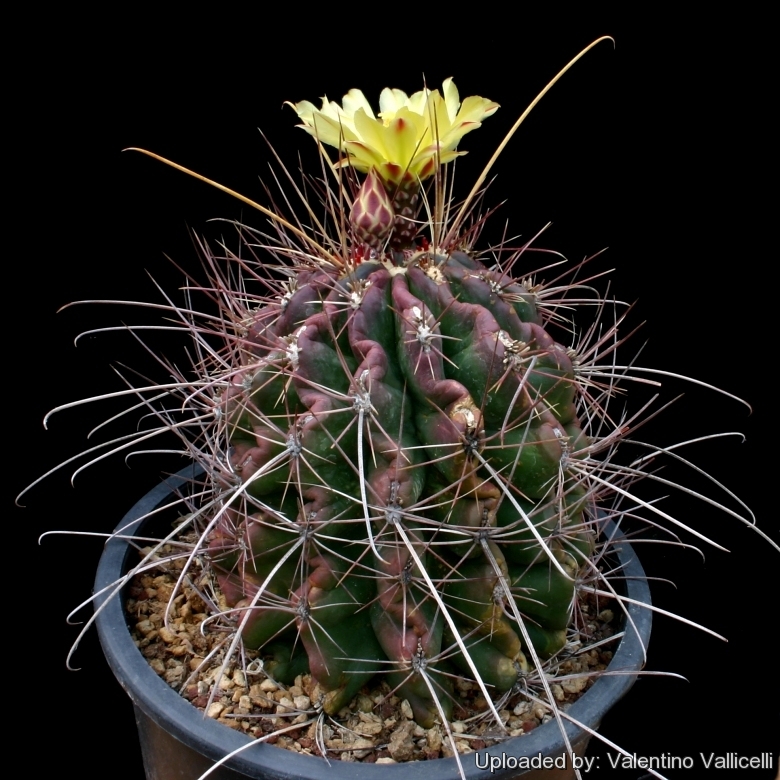
Echinocactus setispinus var. longihamatus (Ferocactus hamatacanthus var. longihamatus) Photo by: Valentino Vallicelli
Origin and Habitat: Durango, Mexico
Altitude: Around 1200 metres above sea level.
Synonyms:
See all synonyms of Ferocactus hamatacanthus
Common Names include:
ENGLISH: Turk's Head
Description: Ferocactus hamatacanthusSN|3403]]SN|3403]] var. longihamatus is one of the many geographical form of the widespread and morphologically variable Ferocactus hamatacanthusSN|3403]]SN|3403]]. Many of its morphological and geographical variant was early classified as different independent species, but nowadays all this plant are considered part of a multiform species, where each form is linked to others by populations of plants with intermediate characteristics. Ferocactus hamatacanthusSN|3403]]SN|3403]] var. longihamatus has great rounded ribs composed of massive tubercles swelling around each areole and very long central spines, curved or slighly hooked.
Habit: Solitary, or sparsely clumping
Stems: Spheric to ovoid, dark green 10-30 × 7.5-20 cm.
Ribs: typically 13 ( to 17), undulate to deeply crenate, with massive tubercles swelling around each areole.
Areoles: 1-3 cm apart, young ones with yellow felt. The areolar gland are numerous bright red up to 1 cm long.
Spines: 12-16 per areole.
Central spines: Up to 4 per areole, very long, curved or slightly hooked, principal central spine thin more or less flattened, 5-10(-20) cm long, 0,4-3 mm, more or less flexible.
Flowers: Pale yellow 6-7,5 long, 7-9 cm in diameter; stigma lobes 8-10.
Fruits: Egg-shaped, green, yellow-green, or olive, 20-45 long and 10-35 mm in diameter.
Seeds: About 1 mm.
Blooming season: Early summer to autumn in succession.
More...Subspecies, varieties, forms and cultivars of plants belonging to the Ferocactus hamatacanthus group
 Ferocactus hamatacanthus (Muehlenpf.) Britton & Rose: has stems up to 60 cm tall, ribs rounded but not compressed and brownish-reddish spines. Distribution: Southern Texas, New Mexico, and northern Mexico.
Ferocactus hamatacanthus (Muehlenpf.) Britton & Rose: has stems up to 60 cm tall, ribs rounded but not compressed and brownish-reddish spines. Distribution: Southern Texas, New Mexico, and northern Mexico.- Ferocactus hamatacanthus var. crassispinus (Engelm.) L.D.Benson
 Ferocactus hamatacanthus f. cristata hort.: is a crested cactus that forms fan-shaped stems with especially hooked spines. There are several quite different clones.
Ferocactus hamatacanthus f. cristata hort.: is a crested cactus that forms fan-shaped stems with especially hooked spines. There are several quite different clones. Ferocactus hamatacanthus var. davisii (Houghton): This form differs for having very clear (almost white) and very shining flowers. Distribution: Tamaulipas, Mexico.
Ferocactus hamatacanthus var. davisii (Houghton): This form differs for having very clear (almost white) and very shining flowers. Distribution: Tamaulipas, Mexico. Ferocactus hamatacanthus var. flavispinus (Meinsh.): has long golden yellow spines. In some plants, particularly on the upper one-half or one-third of the stems, the collective dominant colour of the spines is yellow. (Same as Hamatocactus sinuatus ?)
Ferocactus hamatacanthus var. flavispinus (Meinsh.): has long golden yellow spines. In some plants, particularly on the upper one-half or one-third of the stems, the collective dominant colour of the spines is yellow. (Same as Hamatocactus sinuatus ?) Ferocactus hamatacanthus var. longihamatus (Galeotti ex Pfeiff.): has great rounded ribs composed of massive tubercles swelling around each areole and very long central spines, curved or slighly hooked. Distribution: Durango.
Ferocactus hamatacanthus var. longihamatus (Galeotti ex Pfeiff.): has great rounded ribs composed of massive tubercles swelling around each areole and very long central spines, curved or slighly hooked. Distribution: Durango. Ferocactus hamatacanthus var. papyracanthus (Kunth): has central spines apically hooked or almost twist into ringlets, principal central spine flattened more or less papery. Distribution: Tamaulipas.
Ferocactus hamatacanthus var. papyracanthus (Kunth): has central spines apically hooked or almost twist into ringlets, principal central spine flattened more or less papery. Distribution: Tamaulipas. Ferocactus hamatacanthus subs. sinuatus (A.Dietr.) N.P.Taylor: Recognizable for its smaller stem up to 30 cm tall and 20 cm in diamter. Ribs are about 13, narrow and more acute at the crest than in var. hamatacanthus. Distribution: plain of the Rio Grande in southeastern Texas and neighboring Mexico.
Ferocactus hamatacanthus subs. sinuatus (A.Dietr.) N.P.Taylor: Recognizable for its smaller stem up to 30 cm tall and 20 cm in diamter. Ribs are about 13, narrow and more acute at the crest than in var. hamatacanthus. Distribution: plain of the Rio Grande in southeastern Texas and neighboring Mexico. Ferocactus hamatacanthus subs. sinuatus f. cristatus hort.: Crested form, recognizable for the yellow spines. Known in cultivation only.
Ferocactus hamatacanthus subs. sinuatus f. cristatus hort.: Crested form, recognizable for the yellow spines. Known in cultivation only.
Bibliography: Major references and further lectures
1) Edward Anderson “The Cactus family” Timber Press, Incorporated, 2001
2) James Cullen, Sabina G. Knees, H. Suzanne Cubey "The European Garden Flora Flowering Plants: A Manual for the Identification of Plants Cultivated in Europe, Both Out-of-Doors and Under Glass" Cambridge University Press, 11/Aug/2011
3) David R Hunt; Nigel P Taylor; Graham Charles; International Cactaceae Systematics Group. "The New Cactus Lexicon" dh books, 2006
4) Urs Eggli, Leonard E. Newton: “Etymological Dictionary of Succulent Plant Names” Springer, Berlin/Heidelberg 2010
5) N. L. Britton, J. N. Rose: “The Cactaceae. Descriptions and Illustrations of Plants of the Cactus Family.” Volume III, The Carnegie Institution of Washington, Washington 1922
6) Brian Loflin, Shirley Loflin “Texas Cacti: A Field Guide” Texas A&M University Press, 26/Oct/2009
7) Albert Michael Powell, James F. Weedin “Cacti of the Trans-Pecos and Adjacent Areas” Texas Tech University Press, 2004
8) Del Weniger “Cacti of Texas and Neighboring States: A Field Guide” University of Texas Press, 1984
More...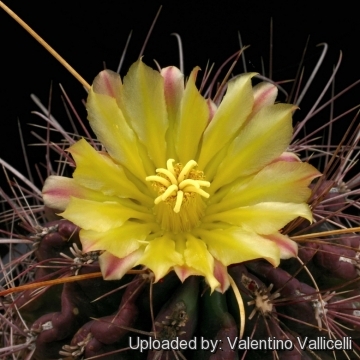 Echinocactus setispinus var. longihamatus (Ferocactus hamatacanthus var. longihamatus) Photo by: Valentino Vallicelli
Echinocactus setispinus var. longihamatus (Ferocactus hamatacanthus var. longihamatus) Photo by: Valentino Vallicelli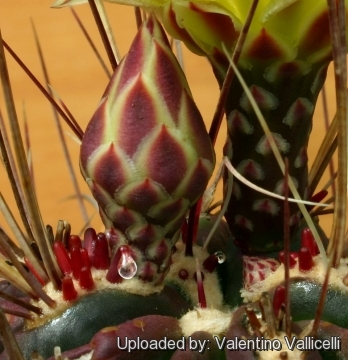 The nectaries with a drop of nectar. (Ferocactus hamatacanthus var. longihamatus) Photo by: Valentino Vallicelli
The nectaries with a drop of nectar. (Ferocactus hamatacanthus var. longihamatus) Photo by: Valentino Vallicelli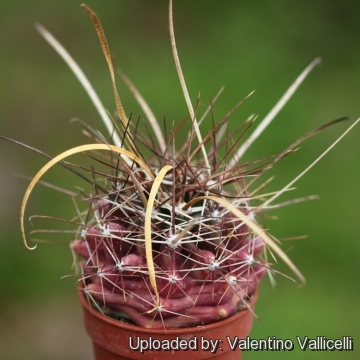 Echinocactus setispinus var. longihamatus (Ferocactus hamatacanthus var. longihamatus) Photo by: Valentino Vallicelli
Echinocactus setispinus var. longihamatus (Ferocactus hamatacanthus var. longihamatus) Photo by: Valentino Vallicelli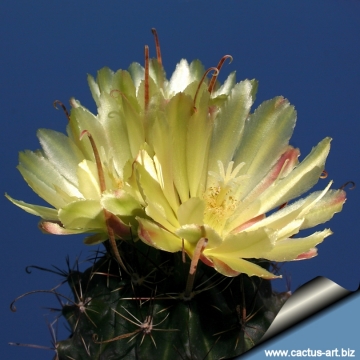 Echinocactus setispinus var. longihamatus (Ferocactus hamatacanthus var. longihamatus) Photo by: Cactus Art
Echinocactus setispinus var. longihamatus (Ferocactus hamatacanthus var. longihamatus) Photo by: Cactus Art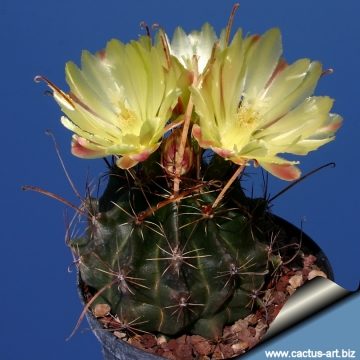 Echinocactus setispinus var. longihamatus (Ferocactus hamatacanthus var. longihamatus) Photo by: Cactus Art
Echinocactus setispinus var. longihamatus (Ferocactus hamatacanthus var. longihamatus) Photo by: Cactus Art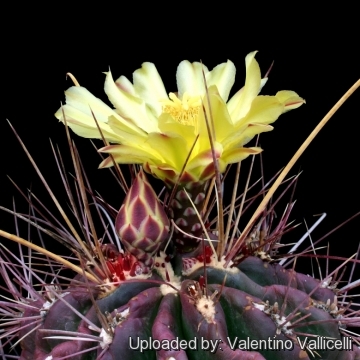 Echinocactus setispinus var. longihamatus (Ferocactus hamatacanthus var. longihamatus) Photo by: Valentino Vallicelli
Echinocactus setispinus var. longihamatus (Ferocactus hamatacanthus var. longihamatus) Photo by: Valentino VallicelliCultivation and Propagation: This species is easy and well worth growing. Require little care once they have reached a nice flowering size. H. simuatus is suited for any rich, well drained soil in full sun throughout the year (But do better with some light shade in summer). Pot culture: grow best in a well-drained container filled with a porous cactus soil mixture that doesn't contain too much humus. To insure robust plants water and fertilize during the aestival growth cycle, this plant need plenty of water (indicatively to about once a week) But needs to be avoided wetting the bodies of these plants while they are in sunlight. A wet cactus in the sun light can cause sun burning which can lead to scars or even fungal infections and death. Care must be taken to prevent sooty mould forming on the sugary secretions from near the areoles.
Frost Tolerance: In winter keep completely dry at 5°C this usually aids in maintaining a healthier plant, but it is hardy to -7°C.
Propagation: Seeds or cutting. Seeds are the typical way of reproducing. These cacti will easily grow from seeds and some from cuttings. Seeds can be sown in the spring or summer in well-drained pots of soil for cacti and sow the seeds thinly on top. Cover them with a bit of fine quartz grit. Moisten and lay a piece of glass across the top. The pots should be set in a warm greenhouse until they start to sprout after which the glass should be progressively removed so they can receive full light and air. It isn't good to keep the glass over the seedlings. The seedlings well developed can be planted separately in small pots.
Cuttings made from pieces of the stem of any size can be detached and laid aside for a few days to allow a protective "skin" to form over the cut. They can then be planted in pots. Place them in a spot where they'll receive sun and do not water until the soil becomes fairly dry. After a while the soil can be moistened regularly but never kept constantly saturated.
More...
















